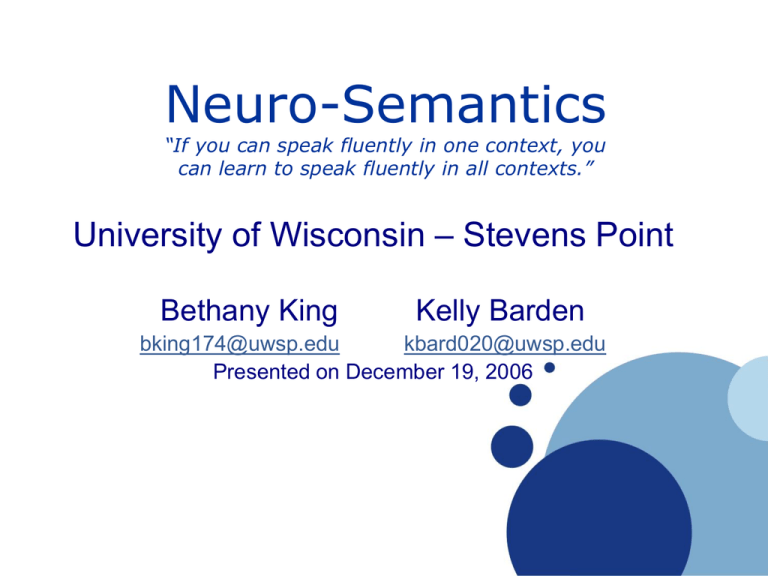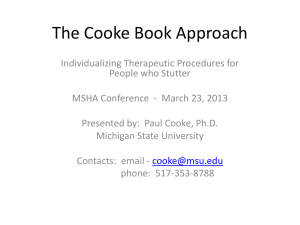Neuro-Semantics – Stevens Point University of Wisconsin Bethany King
advertisement

Neuro-Semantics “If you can speak fluently in one context, you can learn to speak fluently in all contexts.” University of Wisconsin – Stevens Point Bethany King Kelly Barden bking174@uwsp.edu kbard020@uwsp.edu Presented on December 19, 2006 What is Neuro-Semantics? • Neuro-semantics is a model that describes how we make meaning through classifying, associating, and evaluating what we experience – the meanings we make determine the actions we take • Neuro-semantics was created in 1997 by Michael Hall and Bobby Bodenhamer. • Neuro-semantics is about pooling together one’s cognitive resources to realize his or her self-worth • Neuro-semantics is a meta-discipline approach, meaning it is about being aware of your potentials Overview • Though Neuro-Semantics is not effective for everyone who stutters, it has proven to benefit many people who stutter • The Neuro-Semantics approach is not a “cure-all” for stuttering – those who are successful must work hard to obtain fluency Principles of Neuro-Semantics • Cognition explains why most people who stutter can speak fluently in some contexts but not in others • Negative views toward one’s self increase stuttering behaviors • Once a strong sense of self-worth has been developed, the person who stutters gains control of his or her speech • Gaining self-worth empowers the individual to not care what others think of them because of their disfluencies How Neuro-Semantics relates to Disfluency • For disfluency to be viewed in a negative way, it is given unwanted labels such as: “bad, flawed, or wrong” • Negative views are learned in childhood and are carried over into adulthood • These negative views later determine our concept of “self” • These views develop into an external locus of control, determining whether you have the power or resources to control your speech • Specific events and environments may trigger disfluency because of associations made with past negative encounters The 7 Matrices of Neuro-Semantics for Fluency Our sense of: I. Self II. Power/Resourcefulness, Self-Efficacy III. Others’ relationships IV. World V. Time VI. Meaning/Value VII. Purpose/Intent Learned Patterns and Frames of Mind Bodenhamer, Bobby G. (2006). What We Believe About Blocking And Stuttering. Retrieved December 11, 2006 from www.masteringstuttering.com. Thinking about Thinking • We continually think about what we are thinking • This is how we create self-images • Negative and positive thoughts are processed in the same way • Thoughts override previous thoughts (second thoughts change first thoughts) Cognitive Treatment “Perceptual Positions” Borasky, M. (2005). New Hope for People Who Stutter. Retrieved December 11, 2006 from http://www.contentmart.com/ContentMart/content.asp?LinkID=29528&CatID=327&content=1. • First Position – seeing the world from your own point of view; “How does this conversation affect me?” • Second Position – feeling empathy for others and taking their perspective; think about how they view how you are communicating • Third Position – dissociating yourself from the entire conversation; being able to appreciate both perspectives “Perceptual Positions” (continued) • Fourth Position – allows us to understand all of the surrounding contexts (cultural, linguistic, business, family, etc.) in our world • Fifth Position – highest level of perspective; taking on a universal and spiritual view point • The ability for a person to freely move from one position to another is key to controlling stuttering. Pros and Cons Pros • Helps the individual develop a positive self-image • The individual gains control over his/her speech by developing an internal locus of control • Skills generalize to everyday life because Neurosemantics address life-changing behaviors and thought processes Cons • Lacks research • No guidelines on implementing this approach into therapy • No clear description of how change is measured References • Bodenhamer, Bobby G. (2006). What We Believe About Blocking And Stuttering. Retrieved December 11, 2006 from www.masteringstuttering.com. • Bodenhamer, Bobby G. (2005). Mastering Blocking & Stuttering with Neuro-Semantics. Retrieved December 11, 2006 from www.masteringstuttering.com. • Borasky, M. (2005). New Hope for People Who Stutter. Retrieved December 11, 2006 from http://www.contentmart.com/ContentMart/content.asp?LinkI D=29528&CatID=327&content=1.

